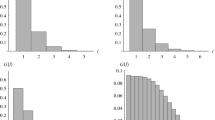Abstract
The empirically oberved “fractal” or “self-similar” nature of packet traffic implies heavy tailed queue processes for such traffic. However, based on our simulation analysis using real network data as well as standard models, we have found that the actual losses sustained are remarkably lower than those suggested by the heavy tail distribution. This can be explained by an effect observed in the tail of the histogram of a finite buffer queue process, which we call “tail-raising”, which contains information pertinent to performance estimation. This effect is also responsible for a significant reduction in packet losses for finite buffer systems, than would be otherwise predicted by the buffer overflow probability for heavy-tailed queues. We define a new parameter X B on the histogram of a queue process for a finite buffer system, to calculate the tail of the queue process based on the information available in the histogram on the finite buffer. We propose an estimator that approximates X B , namely, X min , which is measurable because of the tail-raising effect and has a robust measurement method. The proposed estimator shows promise as a good predictor for performance metrics of queueing systems. We propose an innovative packet loss ratio estimation technique which uses histogram measurements combined with a virtual buffer scheme to find and extrapolate the objective packet loss rate using a binning strategy for histogram measurement, namely, Symmetric Logarithmic Binning (SLB).
Similar content being viewed by others
References
C. Courcoubetis, G. Kesidis, A. Ridder, J. Walrand and R. Weber, Admission control and routing in ATM networks using inferences from measured buffer occupancy, IEEE Transactions on Communications 43(2-4) (1996) 1778-1784.
S. Crosby, I. Leslie, J. Lewis, N. O'Connell, R. Russell and F. Toomey, Bypassing modelling: An investigation of entropy as a traffic descriptor in the Fairisle ATM network in: Proc. of the 12th IEE UK Teletraffic Symposium, Old Windsor, 15–17 March 1995, Paper 23, pp. 1-10.
M.E. Crovella and A. Bestavros, Self-similarity in world-wide-web traffic: Evidence and possible causes in: Proc. of the 1996 ACN SIGMETRICS Conf., Philadelphia, PA, 1996, pp. 160-169.
S.Y. Devadhar, Broadband traffic characterization and performance estimation, Ph.D. dissertation, University of California, Los Angeles, USA (1999).
S.Y. Devadhar, P. Pruthi and M. Gerla, Delay in public frame relay networks: Measurements and modelling, in: Proc. of the 11th ITC Specialist Seminar onMultimedia and Nomadic Communications, Yokohama, Japan, 27–29 October 1998, pp. 100-104.
A. Erramilli, O. Narayan and W. Willinger, Experimental queueing analysis with long-range dependent packet traffic, IEEE/ACM Transactions on Networking 4(2) (1996) 209-223.
W.E. Leland, M.S. Taqqu, W. Willinger and D.V. Wilson, On the self-similar nature of Ethernet traffic (extended version), IEEE/ACM Transactions on Networking 2 (1994) 1-15.
I. Norros, A storage model with self-similar input, Queueing Systems 16(3/4) (1994) 387-396.
V. Paxson and S. Floyd, Wide area traffic: The failure of poisson modeling, IEEE/ACM Transactions on Networking 3 (1995) 226-244.
W. Press, S. Teukolsky, W. Vetterling and B. Flannery, Numerical Recipes in C (Cambridge Univ. Press, Cambridge, 1995) pp. 650-654.
M. Siler and J. Walrand, On-line measurement of QoS for call admission control, in: Sixth IFIP International Workshop on Quality of Service, 1998.
W. Willinger, S.Y. Devadhar, A. Heybey, R. Sherman, M. Sullivan and J. Vollaro, Measuring ATM traffic cell-by-cell: Experiences and preliminary findings from BAGNet, in: Proc. of PMCCN'97, International Conf. on the Performance and Management of Complex Communication Networks, eds. T. Hasegawa, H. Takagi and Y. Takahashi, Tsukuba, Japan, 1997, pp. 91-110.
H. Zhu and V. Frost, In-service monitoring for cell loss quality of service violations in ATMnetworks, IEEE/ACM Transactions on Networking 4(2) (1996) 240-248.
Author information
Authors and Affiliations
Rights and permissions
About this article
Cite this article
Devadhar, S.Y., Gerla, M. & Yu, J. The significance of finite buffer edge effects in histogram measurements of queues. Telecommunication Systems 16, 177–193 (2001). https://doi.org/10.1023/A:1009015231454
Issue Date:
DOI: https://doi.org/10.1023/A:1009015231454




